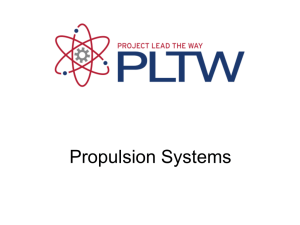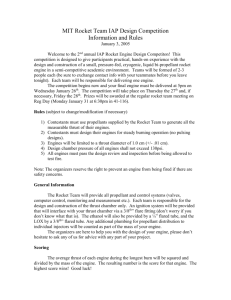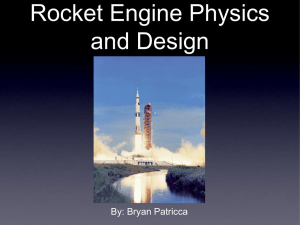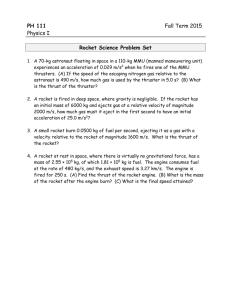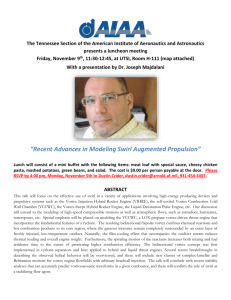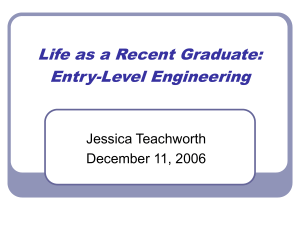Aerospace Propulsion - Colorado Space Grant Consortium
advertisement
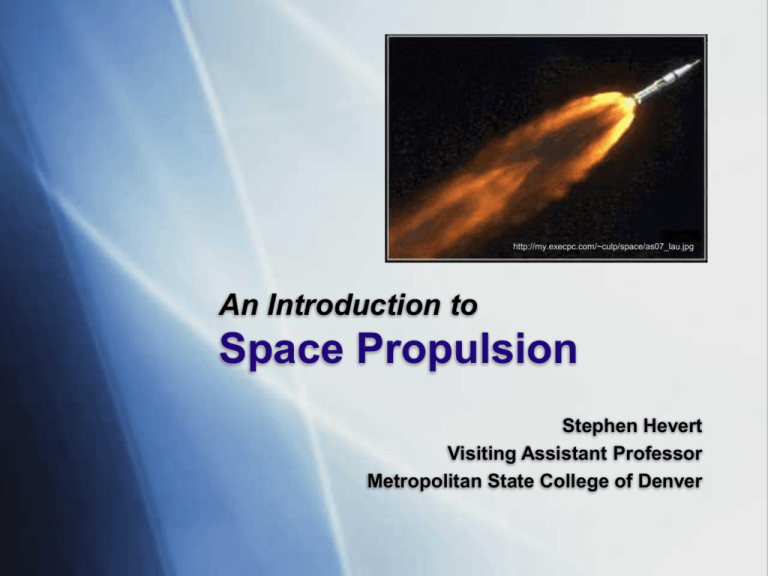
http://my.execpc.com/~culp/space/as07_lau.jpg An Introduction to Space Propulsion Stephen Hevert Visiting Assistant Professor Metropolitan State College of Denver • Initiating or changing the motion of a body • Translational (linear, moving faster or slower) • Rotational (turning about an axis) www.hearlihy.com What Is Propulsion? • Space propulsion • Rocket launches • Controlling satellite motion • Maneuvering spacecraft • Jet propulsion • Using the momentum of ejected mass (propellant) to create a reaction force, inducing motion At one time it was believed that rockets could not work in a vacuum -- they needed air to push against!! Jet Propulsion Classifications • Air-Breathing Systems • Also called duct propulsion. • Vehicle carries own fuel; surrounding air (an oxidizer) is used for combustion and thrust generation • Gas turbine engines on aircraft… …or go karts! • Rocket Propulsion • Vehicle carries own fuel and oxidizer, or other expelled propellant to generate thrust: • Can operate outside of the Earth’s atmosphere • Launch vehicles, upper stages, Earth orbiting satellites and interplanetary spacecraft … or … a rocket powered scooter! www.gadgets-reviews.com www.the-rocketman.com Space Propulsion Applications • • • • • • en.wikipedia.org Launch Vehicles Ballistic Missiles Earth Orbiting Satellites Upper Stages Interplanetary Spacecraft Manned Spaceflight www.army-technology.com www.britannica.com blog.wired.com www.psrd.hawaii.edu Space Propulsion Functions • Primary propulsion • Launch and ascent • Maneuvering • Orbit transfer, station keeping, trajectory correction • Auxiliary propulsion • Attitude control • Reaction control • Momentum management www.nasm.si.edu www.ksc.nasa.gov A Brief History of Rocketry • China (300 B.C.) • Earliest recorded use of rockets • Black powder • Russia (early 1900’s) • Konstantin Tsiolkovsky • Orbital mechanics, rocket equation • United States (1920’s) • Robert Goddard • First liquid fueled rocket (1926) • Germany (1940’s) onenew.wordpress.com Wan-Hu who tried to launch himself to the moon by attaching 47 black powder rockets to a large wicker chair! Dr. Goddard goddard.littleto npublicschools .net • Wernher von Braun • V-2 • Hermann Oberth Dr. von Braun Prof. Tsiolkovsky www.geocities.com www.britannica.com Space Propulsion System Classifications Stored Gas Chemical Electric Advanced • Electrothermal • Electrostatic • Electrodynamic Solid Liquid • Nuclear • Solar thermal • Laser • Antimatter Hybrid Pressure Fed Pump Fed Bipropellant Monopropellant Space propulsion systems are classified by the type of energy source used. Stored Gas Propulsion Propellant Tank Gas Fill Valve P Pressure Gage High Pressure Isolation Valve Filter Pressure Regulator Low Pressure Isolation Valve Thruster • Primary or auxiliary propulsion. • High pressure gas (propellant) is fed to low pressure nozzles through pressure regulator. • Release of gas through nozzles (thrusters) generates thrust. • Currently used for momentum management of the Spitzer Space telescope. • Propellants include nitrogen, helium, nitrous oxide, butane. • Very simple in concept. Chemical Propulsion Classifications • Liquid Propellant www.aerospaceweb.org en.wikivisual.com • Pump Fed • Launch vehicles, large upper stages • Pressure Fed • Smaller upper stages, spacecraft • Monopropellant • Fuel only • Bipropellant • Fuel & oxidizer • Solid Propellant • Launch vehicles, Space Shuttle, spacecraft • Fuel/ox in solid binder • Hybrid news.bbc.co.uk • Solid fuel/liquid ox • Sounding rockets, X Prize Monopropellant Systems Nitrogen or helium Hydrazine Propellant Tank P Fuel Fill Valve Isolation Valve Filter Thrusters Pressure Gage • Hydrazine fuel is most common monopropellant. • N2H4 • Decomposed in thruster using catalyst to produce hot gas for thrust. • Older systems used hydrogen peroxide before the development of hydrazine catalysts. • Typically operate in blowdown mode (pressurant and fuel in common tank). Monopropellant Systems www.ampacisp.com www.aerojet.com Bipropellant Systems OX FUEL P P Isolation Valves Chamber Engine Nozzle • A fuel and an oxidizer are fed to the engine through an injector and combust in the thrust chamber. • Hypergolic: no igniter needed -propellants react on contact in engine. • Cryogenic propellants include LOX (-423 ºF) and LH2 (-297 ºF). • Igniter required • Storable propellants include kerosene (RP-1), hydrazine, nitrogen tetroxide (N2O4), monomethylhydrazine (MMH) Liquid Propellant Systems • Pump fed systems • Propellant delivered to engine using turbopump • Gas turbine drives centrifugal or axial flow pumps • Large, high thrust, long burn systems: launch vehicles, space shuttle • Different cycles developed. H-1 Engine Turbopump A 35’x15’x4.5’ (ave. depth) backyard pool holds about 18,000 gallons of water. How quickly could the F-1 pump empty it? F-1 engine turbopump: • 55,000 bhp turbine drive • 15,471 gpm (RP-1) • 24,811 gpm (LOX) F-1 Engine Turbopump Ans: In 27 seconds! Photos history.nasa.gov Rocket Engine Power Cycles • Gas Generator Cycle www.aero.org/publications/ crosslink/winter2004/03_side bar3.html www.answers.com • Simplest • Most common • Small amount of fuel and oxidizer fed to gas generator • Gas generator combustion products drive turbine • Turbine powers fuel and oxidizer pumps • Turbine exhaust can be vented through pipe/nozzle, or dumped into nozzle • Saturn V F-1 engine used gas generator cycle Rocket Engine Power Cycles - cont • Expander www.aero.org/publications/ crosslink/winter2004/03_sidebar3. html science.nasa.gov • Fuel is heated by nozzle and thrust chamber to increase energy content • Sufficient energy provided to drive turbine • Turbine exhaust is fed to injector and burned in thrust chamber • Higher performance than gas generator cycle • Pratt-Whitney RL-10 Rocket Engine Power Cycles - cont • Staged Combustion www.rocketrelics.com www.aero.org/publications/ crosslink/winter2004/03_side bar3.html shuttle.msfc.nasa.gov • Fuel and oxidizer burned in preburners (fuel/ox rich) • Combustion products drive turbine • Turbine exhaust fed to injector at high pressure • Used for high pressure engines • Most complex, requires sophisticated turbomachinery • Not very common • SSME (2700 psia) The Big Engines… F-1 Engine Saturn V 1.5 million lbs thrust (SL) LOX/Kerosene www.flickr.com Main Engine Space Shuttle 374,000 lbs thrust (SL) LOX/H2 spaceflight.nasa.gov RD-170 1.78 million lbs thrust (SL) LOX/Kerosene www.aerospaceguide.net Solid Propellant Motors • Fuel and oxidizer are in solid binder. • Single use -- no restart capability. • Lower performance than liquid systems, but much simpler. • Applications include launch vehicles, upper stages, and space vehicles. www.aerospaceweb.org www.propaneperformance.com www.nationalmuseum.af.mil Hybrid Motors • Combination liquid-solid propellant Oxidizer Tank • Solid fuel • Liquid oxidizer • Multi-start capability Ox Control Valve • Terminate flow of oxidizer • Fuels consist of rubber or plastic base, and are inert. • Just about anything that burns… Solid Propellant Nozzle • Oxidizers include LO2, hydrogen peroxide (N2O2) and nitrous oxide (NO2) • Shut-down/restart capability. Rocket Performance Calculations • Rocket Equation • Thrust & Specific Impulse • Thrust is the amount of m force generated by the V gIsp ln m i rocket. f • Specific impulse is a measure or engine g 9.8 m/s performance (analogous to m mass of vehicle before burn miles per gallon) m mass of vehicle after burn • Units are seconds m mass of propellant for V m m 2 i f p F Isp w F rocket thrust w weight flowrate of propellant i f V gI sp i 1 e m m p Rocket equation assumes no losses (gravity effects, aerodynamic drag). Actually very accurate for short burns in Earth orbit or in deep space! Specific Impulse Comparison • • • • • • Stored gas Monopropellant hydrazine Solid rocket motors Hybrid rockets Storable bipropellants LOX/LH2 • • • • • • 60-179 sec 185-235 sec 280-300 sec 290-340 sec 300-330 sec 450 sec Specific impulse depends on many factors: altitude, nozzle expansion ratio, mixture ratio (bipropellants), combustion temperature. www.rocketrelics.com This thruster was used on the Viking Lander. It has a specific impulse of about 225 seconds. Mission Delta-V Requirements Mission (duration) Delta-V (km/sec) Earth surface to LEO 7.6 LEO to Earth Escape 3.2 LEO to Mars (0.7 yrs) 5.7 LEO to Neptune (29.9 yrs) 13.4 LEO to Neptune (5.0 yrs) 70 LEO to alpha-Centauri (50 yrs) 30,000 LEO = Low Earth orbit (approx. 274 km) Propellant Calculation Exercise • Determine the mass of propellant to send a 2500 kg spacecraft from LEO to Mars (0.7 yr mission). • Assume the 2500 kg includes the propellant on-board at the start of the burn. • Assume our engine has a specific impulse of 310 sec (typical of a small bipropellant engine). • Use the rocket equation: m p 5700 9.8310 1 e 2500 2117 kg Most of our spacecraft is propellant! Only 383 kg is left for structure, etc! How could we improve this? • Classifications • • • • Electrothermal Electrostatic Electromagnetic Characteristics • • • www-ssc.igpp.ucla.edu Electric Propulsion Very low thrust Very high Isp • > 1000 sec Requires large amounts of power (kilowatts) This image of a xenon ion engine, photographed through a port of the vacuum chamber where it was being tested at NASA's Jet Propulsion Laboratory, shows the faint blue glow of charged atoms being emitted from the engine. The ion propulsion engine is the first non-chemical propulsion to be used as the primary means of propelling a spacecraft. Electrothermal Propulsion • • Electrical power is used to add energy to exhaust products Resistojet • rocket.itsc.uah.edu • • Catalytic decomposition of hydrazine is augmented with high power electric heater 800 – 5,000 W Arcjet • • High voltage arc at nozzle throat adds thermal energy to exhaust Various gaseous or vaporized propellants can be used. www.fathom.com www.nasa.gov www.waynesthisandthat.com Electrostatic Propulsion • Xenon Ion Thruster www.plasma.inpe.br aerospace.engin.umich.edu • Xenon propellant • Electrostatic forces are used to accelerate charged particles to very high velocities • Xenon is ionized by electron bombardment • Thermionic cathode • Positively charged particles accelerated by grid • Electrons routed to second anode and injected into beam to neutralize ESA’s SMART-1 uses a xenon ion propulsion system (XIPS) Electromagnetic Propulsion • Electromagnetic forces are used to accelerate a plasma • A gas consisting of positive ions, electrons • 5000 – 9000 ºR • Neutral beam is produced • Higher thrust per unit area than electrostatic thruster • Classifications www.nasa.gov • Magnetoplasmadynamic • Pulsed plasma • Electric discharge creates plasam from solid Telfon • Hall effect • Developed in Russia • Flew on U.S. STEx mission (1998) The Future • Interplanetary travel will require advanced forms of propulsion technology: • Antimatter • Nuclear fusion • Non-rocket methods References • Theory and design • Sutton, G. P. and Biblarz, O., Rocket Propulsion Elements, 7th ed. ,Wiley, 1987 • A classic; covers most propulsion technologies • Huzel, D.K, and Huang, D. H., Modern Engineering for Design of Liquid Propellant Rocket Engines (revised edition), Progress in Aeronautics and Astronautics, Vol. 147, American Institute for Aeronautics and Astronautics, 1992 • Dieter Huzel was one of the German engineers who came to the U.S. after WW II. • Humble, R. W., et. al., Space Propulsion Design and Anaylsis (revised edition), McGraw-Hill, 1995 • Covers chemical (liquid, solid, hybrid), nuclear, electric, and advanced propulsion systems for deep space travel References - cont • Rocket engine history • Macinnes, P., Rockets: Sulfur, Sputnik and Scramjets, Allen & Unwin, 2003 • Clary, D. A., Rocket Man: Robert H. Goddard and the Birth of the Space Age, Hyperion Special Markets, 2003 • Ordway, F. I. and Sharpe, M., The Rocket Team, Apogee Books, 2003 • The story of Werner von Braun, the V-2 and the transition of the German engineers to the United States following WW II • Sutton, G. P., History of Liquid Propellant Rocket Engines, American Institute for Aeronautics and Astronautics, 2006 • New, over 800 pages of rocket engine history When things go bad… http://www.youtube.com/watch?v=gDnkEOKR1BE



